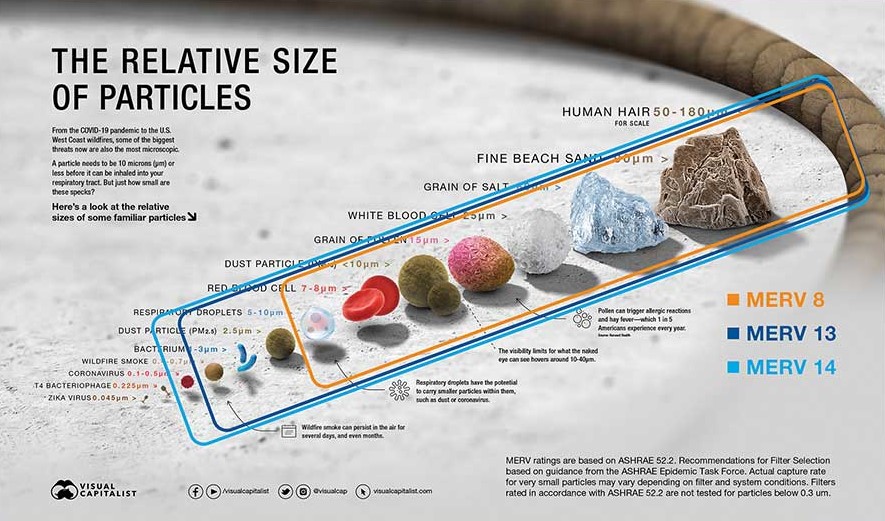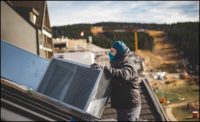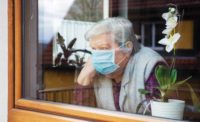Given the ongoing COVID-19 pandemic, the importance of indoor air quality (IAQ) to ensure safe, breathable air in schools has never been more important. Approximately 55 million people, including students, teachers, and support staff, are inside our nation’s K-12 school buildings daily.1 In addition to viral transmission, poor IAQ can cause long- and short-term health problems due to increased indoor pollutants, such as dust, allergens, carbon dioxide, and volatile organic compounds (VOCs), released by various synthetic building materials. Effective and efficient ventilation is the foundation to improving IAQ in schools.
Proper ventilation and good IAQ also improve students' academic performance. Several studies have proven that children in classrooms with higher outdoor air ventilation rates tend to achieve higher scores on standardized tests in math and reading than children in poorly ventilated classrooms.2 Poor ventilation in the form of inadequate air exchanges per hour (ACH) increases absenteeism and negatively impacts the overall health and productivity of teachers and staff.
A well-designed and maintained HVAC system is often the best solution to assure healthy air quality indoors. Unfortunately, many school HVAC systems fall short of being effective. A vast majority of school buildings in the U.S. are 20-50 years old and fail to meet current ventilation requirements. Likewise, many newer buildings also have technologically outdated HVAC systems or do not meet current codes. A Government Accountability Office (GAO) survey reports that, of the school districts surveyed, 41%, or about 36,000 schools, need to update or replace current HVAC equipment.3 Given the value of good ventilation to mitigate the risk of COVID, it's more important than ever to focus on the design and implementation of energy-efficient ventilation systems that deliver fresh, conditioned air and dilute air contaminants in schools.
According to the U.S. Environmental Protection Agency (EPA), good IAQ management in schools consists of the inundation and distribution of outdoor air, control of airborne pollutants, and adequate indoor temperature and relative humidity levels.4 Let’s take a closer look at these, along with the ventilation equipment that provides these functions.
Ventilation
Ensuring good IAQ in classrooms is critical to student health and performance. A 2016 Harvard University study showed improvements in IAQ led to a 61%-101% increase in cognitive learning.5 Paramount to good IAQ is the supply of oxygen-rich conditioned outdoor air and the exhaust of stale, spent air. This fresh outdoor air helps to remove indoor air contaminants, including particulate matter, VOCs, and pathogens, and reduces the carbon dioxide levels in a space. Unfortunately, a recent study showed that 87 out of 100 classrooms have ventilation rates below what is recommended to keep students healthy.6
The U.S. Centers for Disease Control (CDC) cites standards established by ASHRAE when developing its guidelines to ensure the health and safety of building occupants. In particular, Standard 62.1, “Ventilation for Acceptable Indoor Air Quality” sets recommendations for ventilation rates in schools at between 10 and 20 cubic feet per minute (cfm) (5-10 L/s) per person.7 These recommendations are adopted by many state codes and are considered minimum ventilation rates to maintain acceptable IAQ levels.
In the context of SARS-CoV-2, the virus that causes COVID-19 infections, some studies suggest that current code-mandated ventilation rates are inadequate and need to be increased to ensure occupant health and safety. A recent study from the University of Illinois used a model linking carbon dioxide produced by occupants to the infection risk from SARS-CoV-2. While carbon dioxide measurement is not a perfect metric for overall IAQ, it provides a reasonable metric of the respiration rates of the occupants and the respiratory droplets and aerosols in the air. The University of Illinois model quantifies infection probability and spread throughout a building based upon occupancy type, face mask usage and effectiveness, vaccine effectiveness, and other factors. The findings from this study show that increasing ventilation rates to reduce carbon dioxide levels below 800 ppm is equivalent to doubling code-required minimum ventilation rates and can reduce viral transmission throughout a building.8
Air Distribution
Once fresh outdoor air is introduced into a building space, proper air distribution ensures the air is circulating throughout the space effectively. Air is a primary carrier of heat, moisture, and airborne contaminants. The flow path of the supply air plays an important role in determining the flow path of airborne pathogens in a space. The airflow pattern, temperature distribution, and concentration of contaminants, including the flow path of airborne pathogens, can depend on several interrelated factors, including the location and type of diffuser throws, supply air temperature, and size and location of room return grilles. Computational fluid dynamic (CFD) studies have shown that the design of a ventilation system and the resulting airflow patterns play a more important role in controlling the flow path of contaminants than just the supply airflow rate or ACH alone.9 A properly designed air distribution system will ensure fresh supply air reaches the breathing zone while drawing stagnant, contaminated air away from the breathing zone.
Equipment Considerations for School Ventilation Systems
Dedicated Outdoor Air Systems (DOAS) and Energy Recovery Equipment — DOAS) can deliver fully conditioned (heated, cooled, humidified) outdoor air at the precise level needed to maintain a healthy and comfortable environment. Operating costs related to increasing ventilation rates to deliver safer air in schools can be minimized by DOAS systems with energy recovery capabilities. Incorporating energy recovery with DOAS equipment can reduce the sensible and latent loads on the system by up to 80%. When increasing ventilation rates to improve IAQ, energy recovery technologies can help to minimize HVAC operational costs. The result is doubly beneficial — improved IAQ and a reduction in HVAC operating costs.

Using HVAC technologies like DOAS and/or incorporating exhaust energy recovery allows a school’s ventilation system to easily exceed the minimum recommended ventilation rate and allows for better control of air temperature and humidity throughout the building. In addition to keeping students and staff more comfortable and productive, studies show that maintaining relative humidity between 40%-60% will reduce the potential for airborne viral transmission (see Figure 1). Utilizing energy recovery with a DOAS will help reduce the cost to humidify or dehumidify ventilation air. Supplemental humidification and/or dehumidification may also be required to maintain humidification levels that reduce the concentration of pathogens.
Air Filters — Air filtration is another tool to improve IAQ. HVAC systems typically utilize filters with a minimum efficiency reporting value (MERV) rating of 8. MERV-8 filters are effective at capturing large particles, such as dust and pollen, but are not effective at capturing smaller pathogens (see Figure 2). ASHRAE’s Epidemic Task Force (ETF) recommends upgrading to HVAC filters with a MERV-13 rating or higher. MERV-13 filters can capture approximately 85% of airborne respiratory particles.10 When upgrading to MERV-13 or higher filters, it’s important to consider the increased resistance to airflow. Given that most fans are selected based on the pressure drop of a “loaded” filter, existing fans are typically capable of handling the increased resistance of a MERV-13 filter. However, because the higher MERV-13 filters will capture more particulates, they will need to be changed more frequently than MERV-8 filters. In rare applications, it may be necessary to increase fan motor size and/or reinforce duct work resulting from higher filter pressure drop.

Grilles, Registers, Diffusers (GRDs) — Grilles, registers, and diffusers play an important role in air distribution. Grilles cover duct openings where air is removed from an indoor space and returned to the HVAC system for reconditioning or exhausted from the building. Registers supply conditioned air into the indoor space, while diffusers push conditioned air into the space in a set pattern for optimal airflow distribution. Consult ASHRAE Standard 55, “Thermal Environmental Conditions for Human Occupancy,” for guidance on how to account for air temperature, radiant air temperature, air speed, and humidity when determining the placement and number of grilles, registers, and diffusers in a given space.
High-Volume, Low-Speed (HVLS) Fans — HVLS fans can also help improve air distribution, especially in large common areas within a school building, such as gymnasiums, auditoriums, and cafeterias. The Air Movement and Control Association Intl. (AMCA) recently commissioned numerical-simulation studies of airborne particle and aerosol transmission with large-diameter ceiling fans (another name for HVLS fans) and concluded that running HVLS fans continuously and at high speeds helps to dilute particle concentrations near building occupants.11
Additive Technologies/Equipment — Additive technologies can be an option to supplement the proven foundational HVAC IAQ technologies of ventilation, filtration, and humidification. Examples of additive technologies include electronic air cleaners (e.g., bipolar ionization), chemical air cleaners (involving physisorption or chemisorption), and reactive air cleaners (e.g., ultraviolet germicidal irradiation [UVGI]). New applications combine UV-C lighting with air movement provided by overhead HVLS fans to deactivate airborne viruses and bacteria (see Figure 3). Studies have shown that ceiling fans can increase the effectiveness of upper-room UVGI devices by more than 60% when used together due to the improvement in air mixing and distribution provided by the fans.12

Should it be necessary to use additive technologies in a school HVAC system, consider the target contaminants, the location (in-room versus in-duct), independent third-party performance verification, and/or clinical studies that assure and verify performance in similar applications. And, lastly, confirm that the device and technology have undergone proper safety testing in school environments.
Third-Party Performance Verification
When evaluating and specifying any new HVAC equipment, make sure manufacturer performance claims are verified by an independent third-party certified ratings program. Several trade associations, such as AMCA; the Air-Conditioning, Heating, and Refrigeration Institute (AHRI); and the Home Ventilating Institute (HVI), have excellent performance certification programs in place to ensure manufacturers’ products perform as specified. Specifying independent third-party performance certification is the best way for design engineers, installing contractors, and owners to hold manufacturers accountable for equipment performance specifications.
Importance of Energy Efficiency
According to the U.S. Department of Energy, HVAC systems typically account for approximately 35% of the energy usage in commercial buildings. To minimize HVAC operating costs when incorporating IAQ upgrades, it's important to consider the latest edition of ASHRAE 90.1, “Energy Standard for Buildings Except Low-Rise Residential Buildings.” Following ASHRAE 90.1 guidelines will help minimize energy costs and ensure upgrades meet local energy requirements. It's also important to note that DOE requires all states certify that local energy codes comply with the latest edition of 90.1. ASHRAE 90.1 is updated on three-year intervals, and DOE requires all states meet or exceed the efficiency levels of 90.1-2019 by July 28, 2023.
Engineering for Schools
Many schools are missing the latest technological advancements designed to bring fresh outdoor air into their buildings to improve health and save energy. Elementary and Secondary School Emergency Relief (ESSER) funds are available now to allow for maintenance and upgrades to school HVAC systems. Efficient ventilation and effective air distribution are time-tested and proven strategies to help improve IAQ and mitigate risks associated with airborne pathogens. Utilizing newer, energy-saving HVAC technologies allows schools to meet and exceed the recommended ventilation requirements while minimizing operating costs.
References
1 AASA The School Superintendents Association “Correlating Indoor Air to Student Academic Performance,” https://www.aasa.org/schooladministratorarticle.aspx?id=6108
2 Environmental Protection Agency, Evidence from Scientific Literature about Improved Academic Performance, https://www.epa.gov/iaq-schools/evidence-scientific-literature-about-improved-academic-performance#IAQIAP_AdequateAir
3 Government Accountability Office, “K-12 Education: School Districts Frequently Identified Multiple Building Systems Needing Updates or Replacement,” https://www.gao.gov/products/gao-20-494
4 Environmental Protection Agency, Why Indoor Air Quality is Important in Schools, https://www.epa.gov/iaq-schools/why-indoor-air-quality-important-schools
5 Harvard Library Office for Scholarly Communication, “Associations of Cognitive Function Scores with Carbon Dioxide, Ventilation, and Volatile Organic Compound Exposures in Office Workers: A Controlled Exposure Study of Green and Conventional Office Environments,” http://nrs.harvard.edu/urn-3:HUL.InstRepos:27662232
6 Berkeley Lab Indoor Air Quality Scientific Findings Resource Bank, “Ventilation Rates and School Performance,” https://iaqscience.lbl.gov/ventilation-rates-and-school-performance-human-performance
7 ASHRAE, ASHRAE Standard 62.1-2004, “Ventilation for Acceptable Indoor Air Quality.” American Society for Heating, Refrigerating, and Air-Conditioning Engineers Inc., https://www.ashrae.org/technical-resources/standards-and-guidelines/read-only-versions-of-ashrae-standards
8 University of Illinois, “Increased Ventilation,” https://smartenergy.illinois.edu/increased-ventilation
9 Kishor Khankari, Ph.D., Mass Balance Analysis of Air Change Rate (ACR) and Space Volume on Contaminant Dilution, https://ansight.com/publications/mass-balance-analysis-of-air-change-rate-acr-and-space-volume-on-contaminant-dilution/
10 ASHRAE Guidance on the Reopening of Schools, https://www.ashrae.org/file library/technical resources/covid-19/guidance-for-the-re-opening-of-schools.pdf
11 AMCA Covid-19 Guidance for Large-Diameter Ceiling Fans, Leon Wang, Ph.D., P. Eng., Concordia University, Building, Civil, and Environmental Engineering, https://users.encs.concordia.ca/~leonwang/moodle/mod/forum/discuss.php?d=13
12 Environmental Health Perspectives, 110, 95-101 Ko, G., First, M.W., & Burge, H.A. (2002). The characterization of upper-room ultraviolet germicidal irradiation in inactivating airborne microorganisms, https://www.ncbi.nlm.nih.gov/pmc/articles/PMC1240698/



![Figure 1. U.S. Energy-Related Carbon Dioxide Emissions, 1990-2013. [2] Figure 1. U.S. Energy-Related Carbon Dioxide Emissions, 1990-2013. [2]](https://www.esmagazine.com/ext/resources/ISSUES/2020/07-July/Carbon-and-Water-Consumption_Feb22-2019.jpg?height=200&t=1594601673&width=200)

